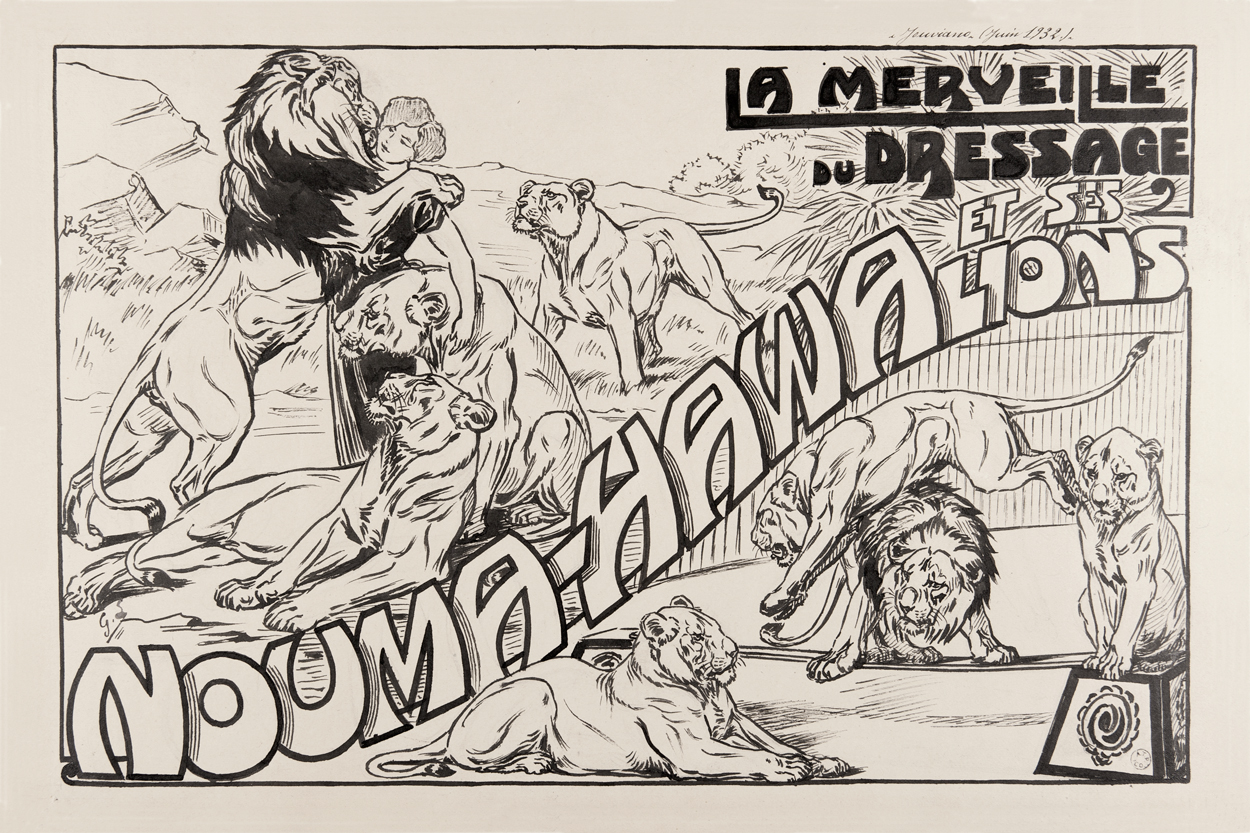
Draw Me a Lion
The Animal Art of Gustave Soury
Gustave Soury (1844-1966) was an illustrator, painter, poster artist and advertising artist who specialized in animal art for circuses and funfair menageries. His vast, meticulous oeuvre, dominated by figures of big cats, bears witness to his passion, but also his fascination, for our urban society and for exotic animals, their frightening savagery and their touching intimate moments.
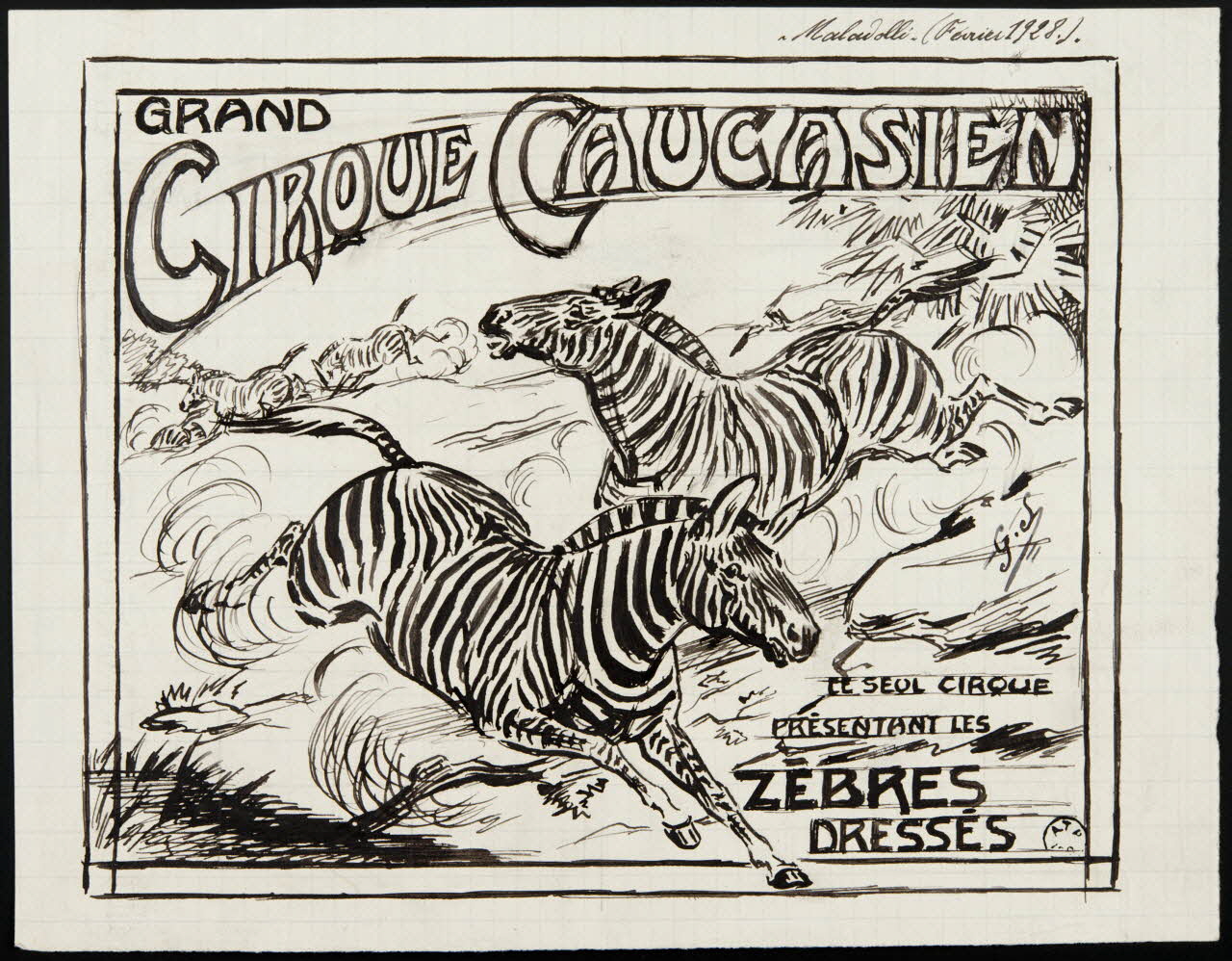
Projet d’affiche pour le Grand Cirque caucasien, Gustave Soury, 1928, Mucem
1964.23.43
An artist behind bars (but on the right side)
At the turn of the 20th century, Gustave Soury was a lace painter, a profession that he exercised “conscientiously, but unenthusiastically”, as he himself put it (according to Adrian, a journalist specializing in the circus world). During his free time, he would visit the menageries of Paris where people could go to admire animals of all sorts and of every origin in their cages. He was a regular visitor to Pezon Menagerie and the one in the Jardin des Plantes botanical garden. While there, he became familiar with the beasts and their tamers, and entertained himself by drawing them in little sketchbooks. It was trainer Alexis “Tana” Tanalias, then working for the Bostock Funfair at the racetrack on Place Clichy, who encouraged him to become a professional animal painter. Himself a sometime illustrator and painter, Tana suggested that Gustave Soury present his sketches and studies in the form of postcards. He passed them along to Bostock, who gushed over the drawings and decided not to make them into postcards, but rather into posters. Leaving the lace industry, Gustave Soury dove head first into the world of menageries and circuses, working in turn as a cashier for tamer Mac Donald, administrator of Professor Maladolli’s Caucasian Circus and as assistant to Henry Thétard, educational walking tour guide at the Vincennes Zoo.
Gustave Soury made a first donation to the museum (then the National Museum of Popular Arts and Traditions) of preparatory sketches for menagerie posters. Upon his death, his archives were also bequeathed to the museum: more than 10,000 photographs and postcards, that he had organized in 31 thematic albums on funfairs and circuses, more than 600 small posters for shows performed between 1880 and 1914, all of his sketchbooks, the reproductions and preparatory work for the pieces he created for the menageries, circuses and other kennels that employed him.
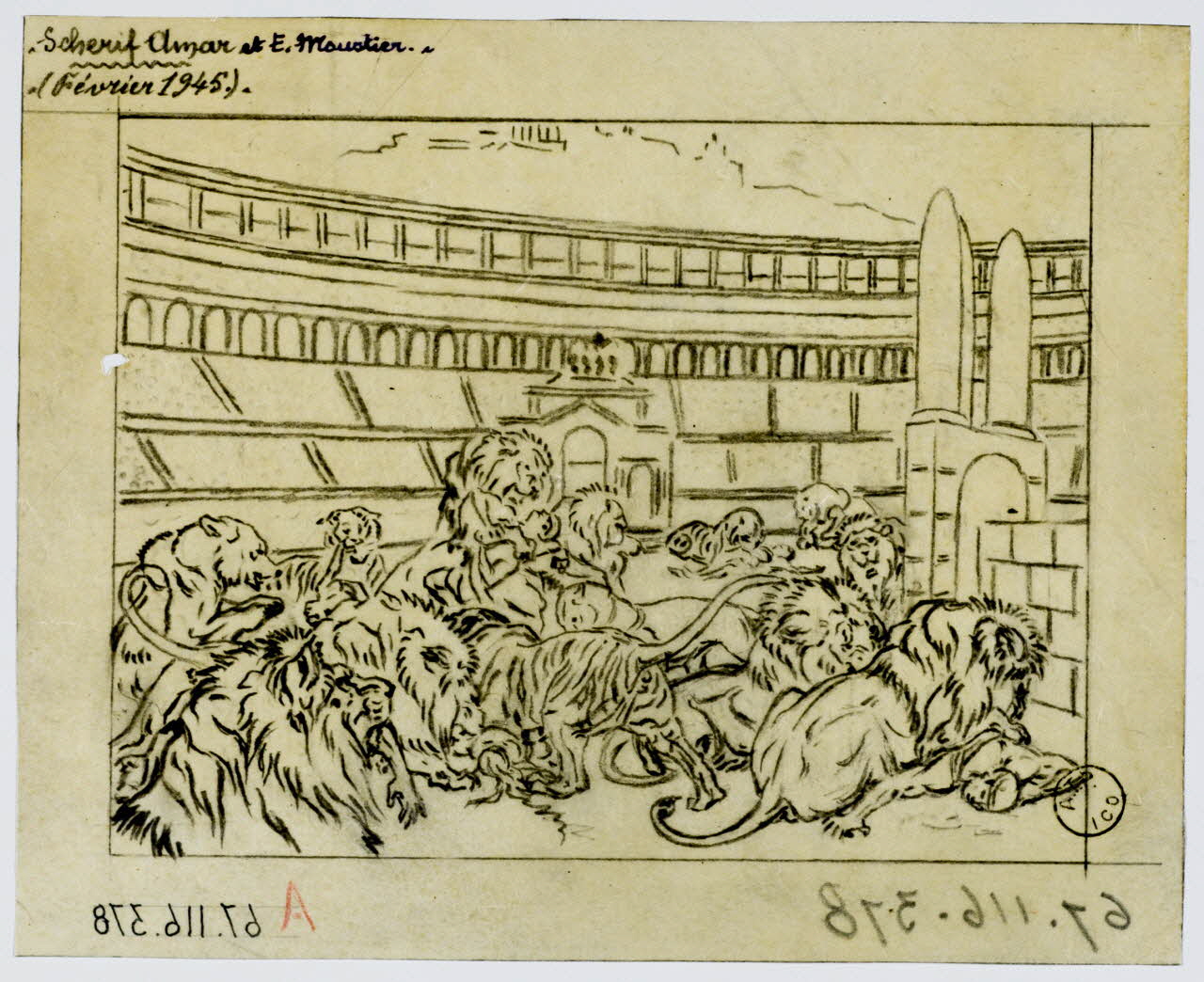
Martyre de chrétiens dans un cirque romain où l’on trouve quelque parallèle avec l’œuvre de Gérôme, 1945, Gustave Soury, Mucem
1967.116.378
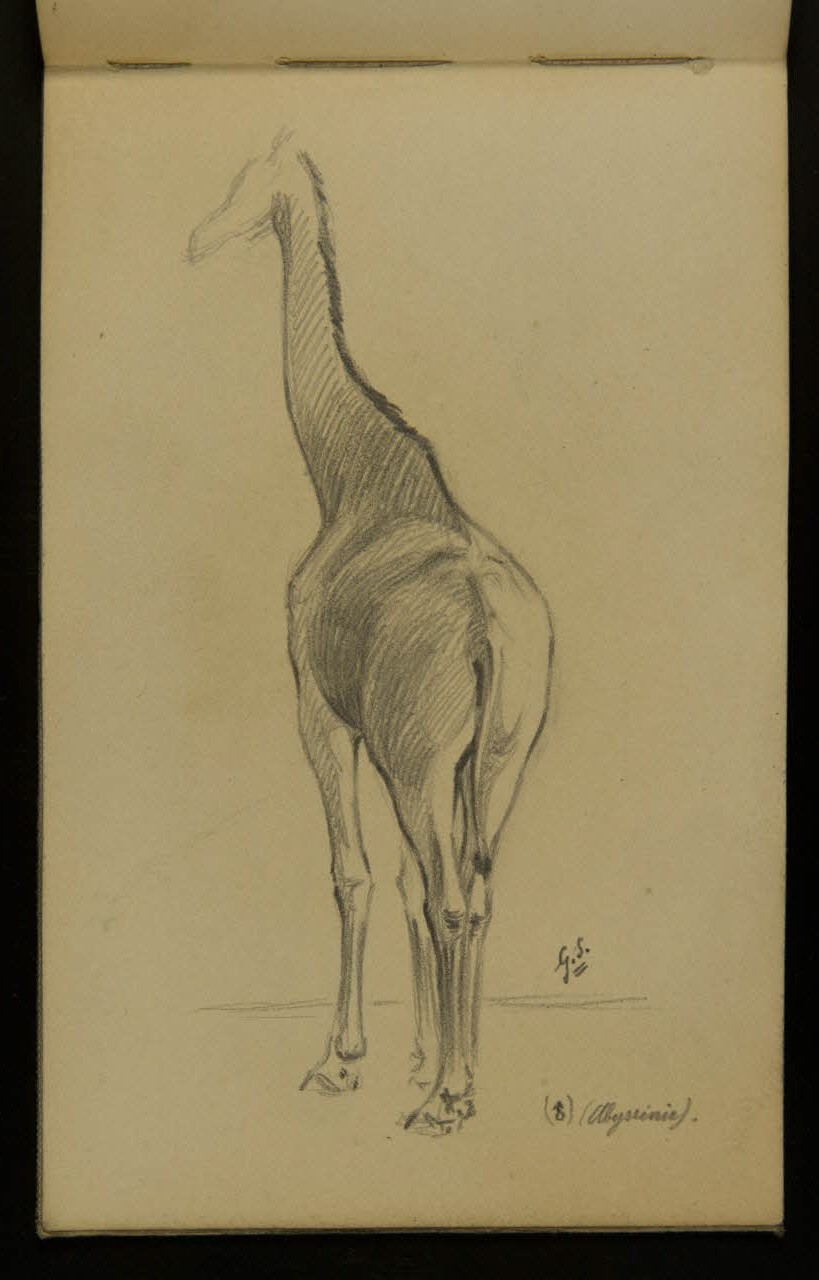
Girafe de dos, 1916—1918, Gustave Soury, Mucem
1967.116.937.46
The artist who cut his teeth on beasts / The artist’s touch
Gustave Soury was far from the first artist to cut his teeth on exotic animals. In fact, he was part of a tradition that was revived in the 19th century: romantic painters like Delacroix and Géricault devoted special attention to lions, those symbols of freedom and wild nature that the conquest of Algeria had brought back to the forefront. Jean-Léon Gérôme also – albeit in a more academic style – often gave a crucial role to big cats in his dramatic scenes of the Orient or inspired by the Roman Circus Games. Gérôme would observe those big cats at Pezon Menagerie, where Gustave Soury would follow in his footsteps a few years later, sketchpads and pencils in hand.
More than all the rest of his oeuvre, Gustave Soury’s notebooks filled with sketches and very preliminary drawings reveal the artist’s true talent. While his menagerie advertisements stage the animals in the most majestic poses, his sketchbooks show them as they could be seen, as they lived – very peacefully – in the menageries of Paris. On each page, there appears a variety of resting panthers, slumping lions, sleeping jaguars and drowsy bears... a far cry from the acrobatics of the circus. Moreover, Gustave Soury excelled at portraying animals from behind and in not particularly academic but highly natural positions that must have aroused his curiosity as a sketch artist. As an expert in the anatomy of the creatures that he observed with meticulous care and tirelessly reproduced, he was able to sketch out their silhouette in a few lines, very expressively reproducing their physiognomy, their poses and even their humblest postures. Adrian, a journalist specializing in the circus during the 1960s and a great admirer of his work, reported that his drawings’ resemblance to their models was such that tamers were able to recognize their own beasts.
Those sketchbooks, where he systematically noted the species of each animal, its sex, the location and often the date, were the tools of his trade first and foremost. In them, the artist created a large number of technical studies and more or less elaborate sketches. In particular, there are images of panthers and tigers for which he had only just begun to draw the complex patterns of the big cats’ pelts. And so he shows us, unexpected spectators that we are (since his sketchbooks were not intended for exhibition) strange creatures with incomplete coats of fur.
In his posters and other advertisements – pieces that he carefully organized – he needed to use a hand that was less free and more composed, but that also testified to his expertise. For example, to be able to reproduce his preparatory studies on a larger scale and in multiple copies, but also to respect the proportions of each figure, he employed gridding or squaring, a technique dating back to Antiquity and the beginnings of academic drawing. Likewise, he constructed some of his work according to the principle of axial symmetry, using tracing paper that allowed him to produce a frontal figure that was exactly symmetrically and perfectly proportioned. These animal heads, more perfect than nature itself, are of enhanced formal excellence, but depart from the naturalism of his sketches which are undoubtedly more personal and more moving.
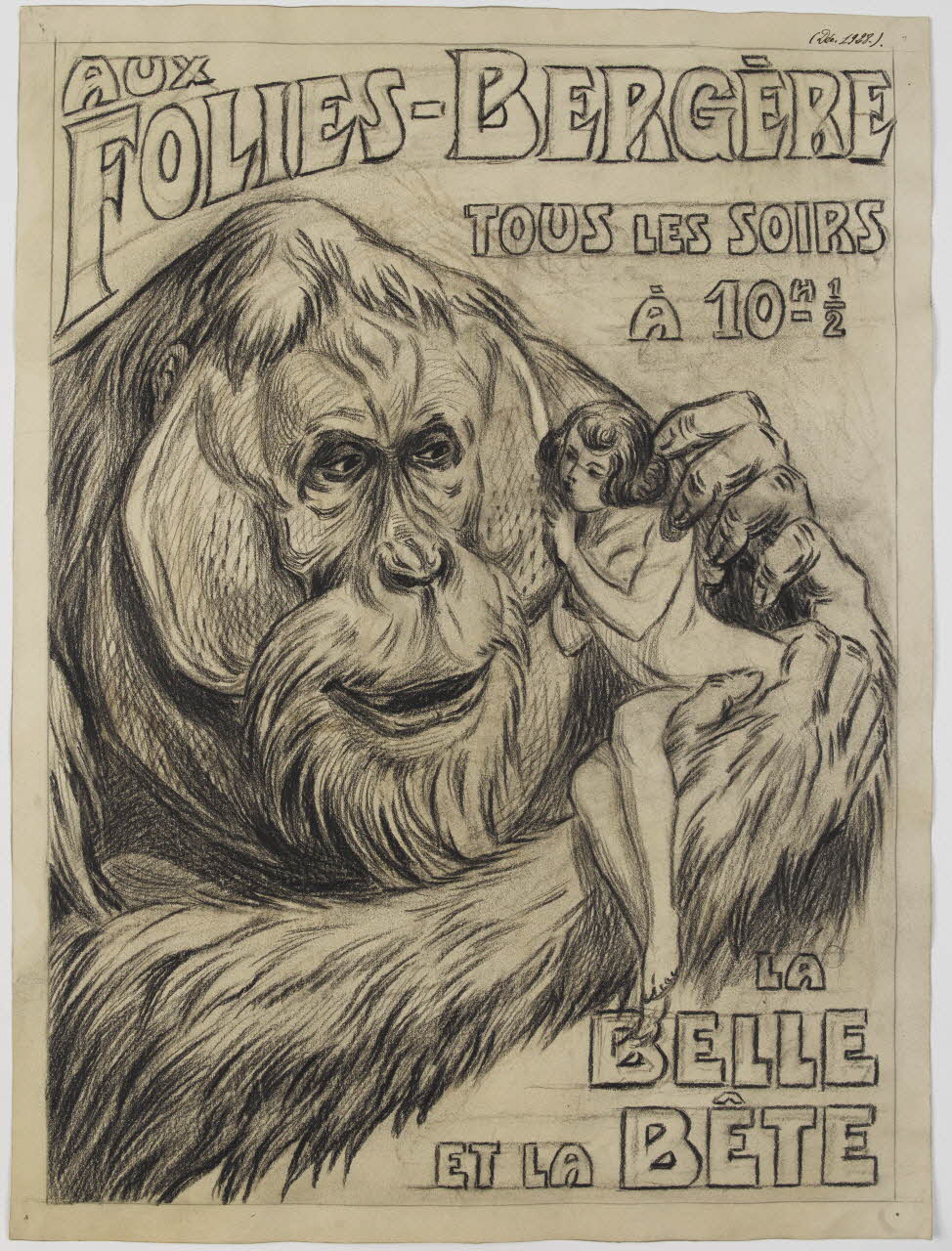
Projet d’affiche pour les Folies-Bergère, 1928, Gustave Soury, Mucem
1967.116.62
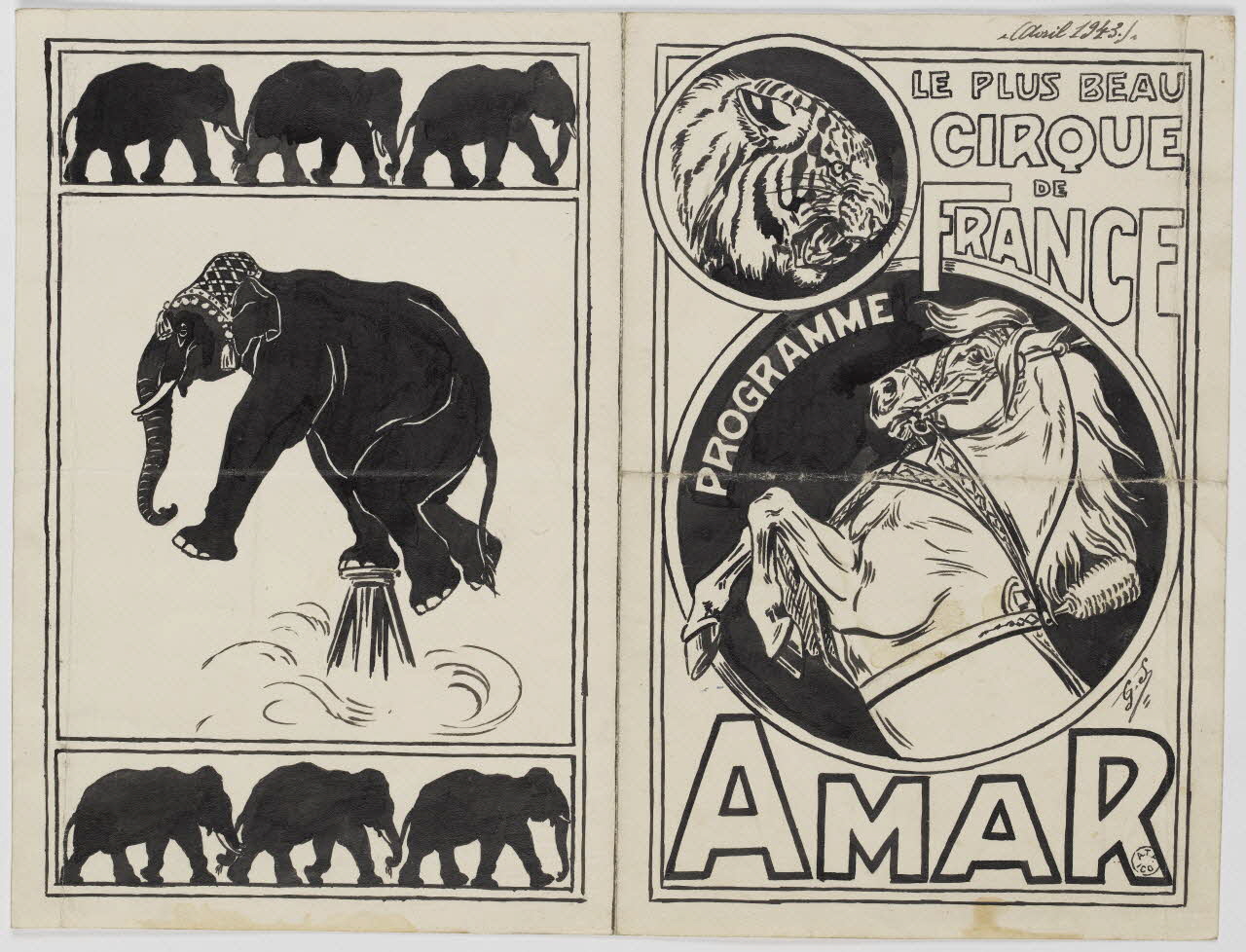
Projet de couverture de programme, 1943, Gustave Soury, Mucem
1964.23.76
Commissions from menageries
Animal painter seems to us to be a very booming profession, and we might wonder what outlets Gustave Soury might have found today for his talent and his passion. It is easy to forget that, between the 1870s and the First World War, travelling menageries attracted crowds of visitors curious to see exotic, often dangerous creatures in real life. Afterwards, their appeal gradually declined, and Gustave Soury himself counted no more than a half dozen in France in the early 1950s. Like circuses and zoos, those menageries based their advertising on the portrayal of the animals that they put on display. To stage those fascinating creatures and make the public want to see and meet them, circus and menagerie managers called on the services of artists the likes of Gustave Soury. More broadly, any firm that wanted to communicate through the image of an animal – however wild – could commission a piece from Gustave Soury.
Advertising
Gustave Soury’s personal archives bequeathed to the museum include various communication media for which circuses and menageries commissioned his talent as an animal sketch artist, graphic artist and poster artist. In fact, Gustave Soury produced posters for most of the major circuses and menageries and for shows by the most famous lion tamers of the times, of which we mostly have the drafts and works in progress. For example, he created a large number of posters for the Amar Family, famous lion tamers and owners of a circus and menagerie that was founded in the early 20th century by a Kabyle man from Algeria, Ahmed Ben Amar.
In addition to posters, Gustave Soury set his big cats and other exotic animals down on all sorts of advertising media: show programmes, menagerie catalogues, promotional postcards, promotional inserts for the press, business cards, and business envelopes and letterhead, including his own.
A large part of his work also consisted of designing the décor for the façades, frontages and entry gates of major menageries, intended to showcase the majesty and the ferocity of the creatures that the public could discover inside. For example, the Mucem has the preparatory drawings for two paintings of African wildlife, designed to frame the entrance to Louis Troisvallets Menagerie. Several of the old photos collected by Soury show examples of this type of façade and the layout of the animal paintings which were often epic or dramatic.
Work in progress
In reality, the majority of Gustave Soury’s work that was donated to the museum comprises steps in the production process of those communication documents for major menageries and animal farms. They give us some insight into his process. Some sketches, that were already highly expressive, include indications of the planned colours for the trainers’ costumes and the décor. Many draft posters, painted in ink on paper, also have their exact correspondent in graphite pencil on tracing paper. You can also follow the trail of a setter with a troubling expression drawn on tracing paper in 1949 and inserted into a coloured draft of a poster for Maison Blanche Kennels in Paris. In some instances, you can admire the published result, for example on an advertising card for trainer Frank-Henry’s “Jungle” showing a fierce combat between two lions. Or on the completed versions of professional letterhead in our possession, into which the photographic portraits of lion tamers have been inserted. In the case of trainer Félix Petit and his partner Miss Eliane, their names had been hand-written by Gustave Soury in the place of their faces, and between the draft and the final image, you can see that their “magnificent” lions became “superb”…
The lives of the animals (and their tamers)
Violence
Magnificent and superb, these are the obvious adjectives – or at least the ones that the artist wants to suggest – when you encounter Gustave Soury’s wildlife in his menagerie creations. While his sketchbooks tend to show animals that are peaceful, even limp or perhaps bored, his advertising art clearly focuses on their ferocity and their power, in scenes where the dramatic tension is often at its peak. Many are the beasts we see roaring, growling or opening wide their mouths full of fearsome teeth, ready to devour. Big cats in particular, which seem to have been the favourites of the artist, his clients and the general public, were almost systematically depicted as muscular creatures, agile and bounding, with razor-sharp teeth and claws, implacable predators. Fight scenes were common in this performing art, combats that were as pitiless as they were improbable, between black panther and spotted panther, a tragic battle between two stars, the lion and the tiger, or unequal, bloody struggles between rats and ratters . Even placid herbivores like zebus are not exempt and are portrayed mid-battle. These pieces, designed to attract customers from the façades of the stalls or reproduced on posters, seek to titillate the public’s fascination with horror and brushes with danger.
Moreover, the pinnacle of this unique animal genre is undoubtedly the scene of an accident in which a lion tamer, losing control over the savage nature that he had sought to subdue, is attacked by his own cats. This is a classic painting for the front of a menagerie, undoubtedly used to incite passers-by to come in and see if today might be the day that they would witness such terrible and highly ironic carnage. On multiple occasions, Gustave Soury drew himself into scenes of accidents on stage, namely in a painting for the façade of the Alliés Menagerie, created to commemorate an accident that happened to lion tamer Vincent Franchi.
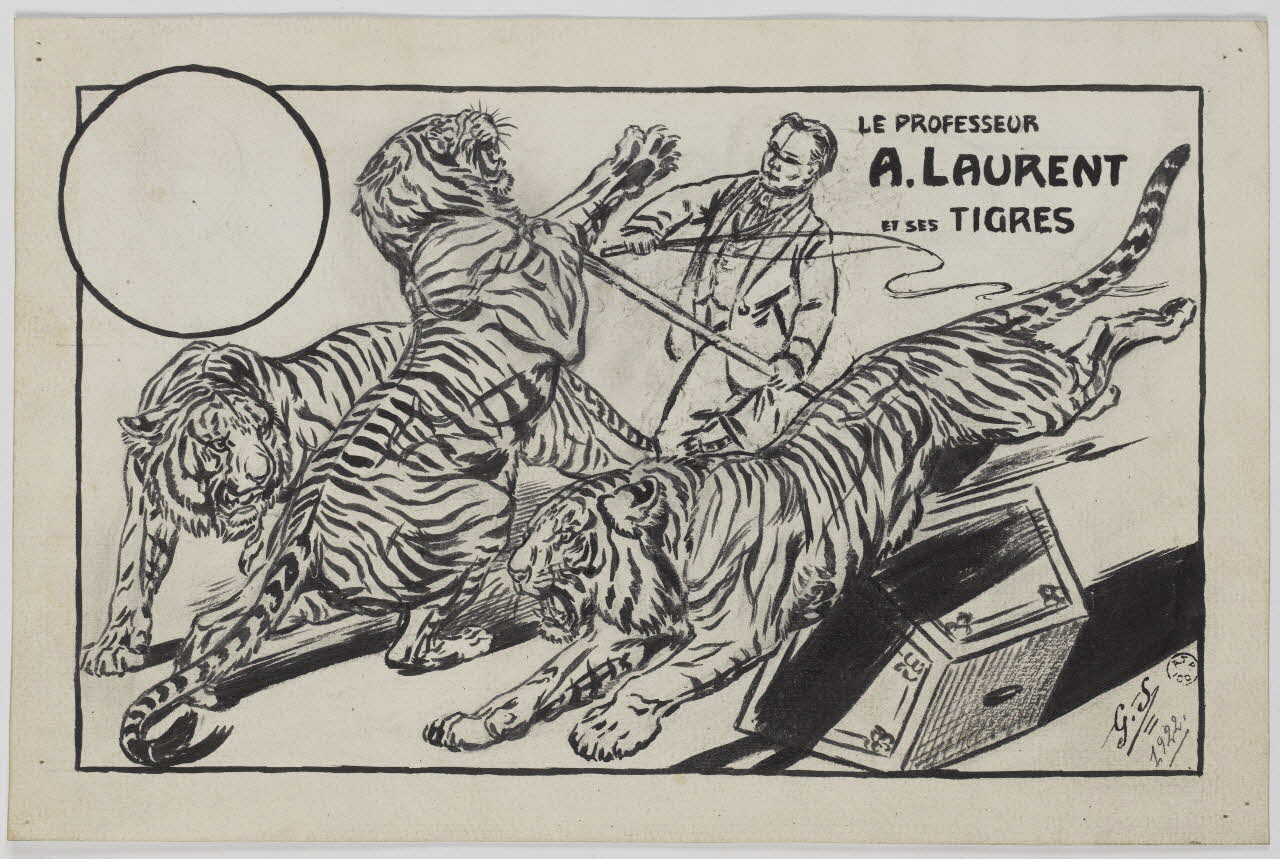
Projet d'affiche pour la ménagerie du professeur Laurent, 1922, Gustave Soury, Mucem
1964.23.45
Eléphante d'Asie entravée, 1944, Gustave Soury, Mucem
1966.5.2
Conflict and tenderness
Aside from this dramatic, even voyeuristic, aspect of Gustave Soury’s work, his creations are also precious accounts of the acts performed at the French circuses and menageries of his era. For example, we can see two opposite styles of shows, playing on two mixed feelings of the public toward the animals. On the one hand, in an act of “ferocious” taming, the trainer plays theatrically with the separation between man and beast, the civilized and the wild. To do this, he cracks his whip with abandon, even uses firearms to work up and repel the cats, that must bristle and roar as much as possible, thrash their tails and bite the bars... This type of highly spectacular act appears in many of Gustave Soury’s drafts, in which lions and tigers leap and rear up in front of their tamer, who seems to keep his cool and a very tight grip on the handle of his whip.
Conversely, a “gentle” taming act underscores the physical proximity and the intimate connection between beast and man, who allays the cats’ natural instincts with a lot of petting and embraces, rather than whipping (at least not in public). Like the photographers of his era, Gustave Soury immortalized the portraits of trainers and their felines, crowding around or tenderly curled up against them. This proximity allows the trainer to fearlessly handle the mouths of his beasts and, potentially, insert his head inside of them. Some of the acts announced in his posters also visibly relied on petting and embraces between the tamer and his co-stars, producing off a more peaceful image, undoubtedly a little idealized and illusory, of the relations between man and animal.
The other side of the picture
While Gustave Soury’s published pieces show vigorous, agile animals, and his sketchbooks portray them as calm and peaceful, a number of isolated drawings in the collection offer a glimpse into a less amusing aspect of menageries. A more difficult to interpret, small series of chained up Asian elephant cows gives off a sense of profound melancholy, due in part to the natural, lumbering silhouette of the pachyderms, but not just that. The artist did not merely attempt to portray the animal’s anatomy, like in his books of studies, but also their movements constrained by their chains and the shackles themselves.
Likewise, a quick sketch of a scrawny, possibly ill lion scribbled on a big of squared paper, stands in contrast with the proud “kings of the beasts” to which we have become accustomed in Gustave Soury’s sketchbooks and posters. With this drawing, we cannot tell if the artist is showing us raw realism or the form of caricature in which he sometimes distinguished himself.
Gustave Soury’s other menageries
Gustave Soury’s ability to take down the most representative anatomical details of animals was doubtless inseparable from his talent as a caricaturist. A number of his drawings in the Mucem’s collections display his virtuosity when it came to sketching characters who may or may not have existed, like a portly cleric or an old woman with a protruding chin, but also some of his contemporaries. The big cat specialist left behind, if not caricatures, at least forthright portraits of Mr. Steinhoff of the zoo at the Colonial Exposition of 1931 and Sarah Caryth, famous dancer and repeat performer at the menageries, and her python Mectoub. Lastly, we do not quite know how to explain an odd piece approaching social satire, a watercolour cartoon of a Paris policeman, recognizable for the coat of arms on his kepi, with the face of a bulldog. A savage beast, yet again.
But Gustave Soury is not only a painter of ferocious animals and menageries. While the latter were his most faithful clients, he also worked in many different advertising domains and in what we would call communication today, whether for restaurants, a Parisian ice cream maker or a brand of cigarettes.
Although animal painting and drawing sometimes suffers from a lack of academic recognition outside of a handful of big names from the 18th and 19th centuries (like Jean-Baptiste Oudry and Rosa Bonheur), Gustave Soury nonetheless seized hold of the discipline with great dexterity to make the move into a unique genre with its own codes and expectations, that of the circus and menageries. This world of show business, that plays on the fears and fantasies of its spectators, must have been perfectly suited to an artist like him, who was not short on mischief, nor on a capacity for wonder. This was true to such an extent that some of his art is still a mystery to us today, like this bizarre wild ride that is fantastical, seductive and terrifying, all at once.